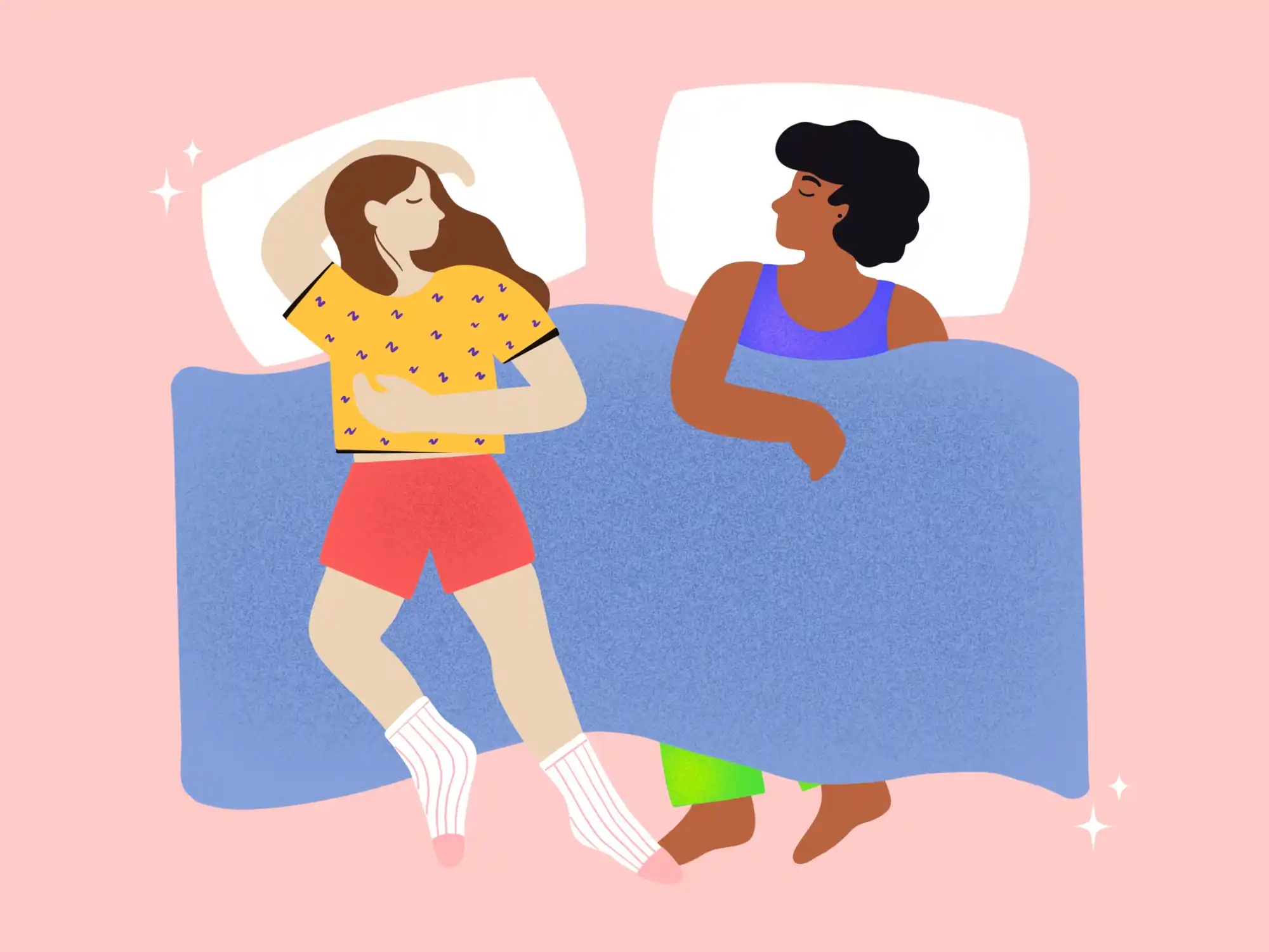Sleep Health
Published May 30, 2022
15 minHow to Fall Asleep Fast (in No Real-Time)
Falling asleep quickly is a challenge for some and a child's play for others. But not being able to fall asleep fast isn't only frustrating; the anxiety that comes from not being able to sleep makes i

Table of contents
How to Fall Asleep in 10 Seconds? How to Fall Asleep in 60 Seconds? How To Fall Asleep In 2 Minutes? Other Ways to Fall Asleep Instantly Final Words Frequently Asked Questions
Falling asleep quickly is a challenge for some and a child's play for others. But not being able to fall asleep fast isn't only frustrating; the anxiety that comes from not being able to sleep makes it harder to relax.Severe deprivation from sleep can have hazardous effects on the mind and body. And then tossing and turning becomes a routine at night, while days continue on a mindless snooze.However, fortunately, some techniques have been introduced on how to fall asleep fast, and they aren't even hard to follow.So let's take a look at the tricks and techniques on how to fall asleep fast and different ways to fall asleep.
How to Fall Asleep in 10 Seconds?
Trying to sleep in 10 seconds is a miracle, even for people who fall asleep fast. However, there are various methods to fall asleep fast, of which some are listed below:1. Military Sleep Method
Sharon Ackerman introduced this method in the book "Relax and Win: Championship and Performance." This method and routine has been developed by military to train their soldiers to be able to sleep in any kind of environment.Steps for Military Sleep Method:
- Lay down comfortably.
- Start with relaxing the facial muscles.
- Exhale and drop the shoulders, relaxing hands comfortably.
- Let lose the leg muscles, relaxing thighs, knees, and calves.
- Clear any remaining thoughts within 10 seconds and imagine calm, peaceful scenes.
- Try saying "don't think" repeatedly for 10 seconds.
2. Avoid Daytime Naps
Trying to sleep at night can become problematic when you have a tiny nap during the day, even for just an hour or two. Sleeping is resetting the body to work longer. And when a person takes naps, they've already reset their body.However, a study shows the relationship between daytime naps and nighttime sleep. In this study, healthy adults and middle-aged people report better performance of tasks with a 20 minutes daytime nap rather than overworking.3. Attention on Consumption
Having a balanced diet plan and a healthy sleep schedule is closely interconnected because the various nutrients consumed can either stimulate the brain into being alert or drowsy.Japanese research studies show that eating carbs four hours before sleeping, like rice, noodles, and bread, promotes better sleep. Since the carbs are easily digested, they'll not trouble the tummy with indigestion; in return, they do not disturb sleep.Note: The above sleeping tips may take a little more than 10 seconds to take into effect, but it is possible to fall asleep fast with practice and resilience.How to Fall Asleep in 60 Seconds?
It takes a little while for some people to fall asleep. But, how to fall asleep fast when not tired? It takes a little bit of breathing and muscle relaxing exercise to fall asleep in no more than 60 seconds. However, these methods can take up to 2 minutes for a beginner to fall asleep.4. Breathing to Fall Asleep (The 4-7-8 Method)
A famous 4-7-8 method was developed by Dr. Andrew Weil. It is a breathing exercise that promotes calmness and relaxation. It is based on the yoga technique that consists of a breath control method that relaxes the nervous system.Steps for One Cycle of the 4-7-8 Method to Fall Asleep:
- Before starting, place the tip of the tongue behind the front teeth, against the root of your mouth
- Part the lips slightly, and exhale with a 'whoosh.'
- Close the lips and inhale through the nose, and count till 4 silently in mind.
- Hold your breath and count till 7.
- Now, exhale with the 'whoosh' and count till 8.
Tips on How to Fall Asleep Fast Using 4-7-8 Breathing Method:
- Try to relax and not be alert while performing it.
- Practice doing it mindlessly rather than consciously.
- Repeat the cycle at least three times.
- When the body is relaxed enough, try to fall asleep.
5. Progressive Muscle Relaxation (PMR)
Progressive muscle relaxation , also called deep muscle relaxation, was introduced by Dr. Edmund Jacobson in the 1930s upon his premise that mental calmness is a natural result of physical relaxation.It's a simple practice of tightening one muscle group at a time, followed by relaxation with the release of tension. This tensing and relaxing of muscles can become an effective remedy for insomnia. Because if you are up most of the night wondering how to fall asleep fast with insomnia, it might've been affecting the body and mind more than you can imagine.How to Fall Asleep Fast Using Muscle Relaxation Script
- Start with the facial muscles. Raise the eyebrows as high as possible, stretching the forehead muscle. Hold it for 5 seconds.
- Relax the stretched muscles, and pause for 10 seconds.
- Now, shut your eyes tightly for 5 seconds, then relax.
- Pause again for 10 seconds.
- Next, smile widely, stretching the cheeks for 5 seconds.
- Relax and pause for 10 seconds.
- Similarly, stretch and relax one set of muscles at a time like the neck, arms, hands, chest, abdomen, legs, and toes.
Tips for Fastest Way to Fall Asleep With the PMR Method
- Before starting Progressive muscle relaxation, practice the 4-7-8 method.
- If relaxed before finishing the tensing and relaxing of muscles, then rest your body and sleep.
- Anyone can learn to practice this technique. It requires only 10 to 20 minutes of practice per day.
6. Schedule It!
Falling asleep fast is also a part of a schedule. Many people follow a strict sleep schedule to stay healthy. Although, for beginners, it may be difficult. But, with time, your body will learn to shut itself down as per the schedule. However, do not force the body to fall asleep. Doing so will only tense the muscles rather than relax them. Also, it may take at least a week of consistency to build up a schedule. And by the time the body gets accustomed to the timing, it'll feel tired enough to fall asleep within seconds on its own.How To Fall Asleep In 2 Minutes?
Still can't sleep? Then there might be some blockage that needs to be dealt with. People usually complain of not being able to fall asleep or not being tired enough to fall asleep. So, what to do when you can't sleep?7. Don't Go to Sleep
That's right. When sleep is the last thing happening, then think of it as such. According to psychology, this method is called paradoxical intention , where the focus shifts from 'trying to fall asleep’ to 'trying to stay awake.'Paradoxical intention is a cognitive behavioral therapy that psychologists use against insomnia patients. It persuades the patients to lie down and stay awake comfortably. While the patient is comfortably awake, their mind eases, and the body starts to relax, making it easier to fall asleep.8. Count the Seconds
Let's take the traditional way to the land of dreams. Instead of breathing exercises and other mind-consuming methods, count sheep. But here's a catch, don't start from one. Instead, go higher and count backward. Sleep expert Dr. Vicky Seelall recommends playing mindless games like counting. Doing so will help the mind focus on one thing and keep it from wandering to other thoughts.9. Visualize Calmness
As cliché as it sounds, it is one of the natural ways to fall asleep. Visualizing or imagining a serene scene can help relax the mind and manage stress. It's like daydreaming, which means it's fine if your thoughts wander off, but make sure to gently return to the original thought. However, there are ways to visualize calmness:- Either visualize the place that brings calmness to mind and helps conjure up serene images, like a clear lakeside, refreshing garden, or anywhere else.
- Or imagine doing something serene or the thing you love most, like the feeling of cold water against your toes, the warm breeze as you swing in the fresh garden of utopia, or anything else.
10. Sleepy Music
Music is one of the most influential and expressive forms of art, and it can be used as a tool to fall asleep. Maybe music can be the lullaby that's needed to fall asleep fast. It is proven that listening to music before going to bed improves sleep efficiency and promotes better rest; there are also fewer cases of waking up during the night. But how to choose the right music?How to Choose the Right Music
- Take note of the tempo. Usually, music is measured in the number of beats per minute (BPM). Studies suggest music around 60-80 BPM is best for falling asleep.
- Avoid songs that bring out emotional reactions. This may distract and distress the mind further, rather than lulling it to sleep.
- It is best to keep the volume low and audible. Because, how much ever calm may the music be, it can disrupt sleep if on a higher volume.
- Avoid using headphones or earbuds; they can damage the ear canal—instead, use speakers or a small stereo.
11. Acupunctures
Acupuncture can become the "off" button for the brain. It is a traditional Chinese medicine practice (TCM) where gentle massage or firm pressure is applied on pressure points to fall asleep. There are many pressure points discussed among the sciences, out of which 3 are listed below.Acupoints to Fall Asleep:
Spirit Gate
- The small hollow space on the wrist down to the pinky finger side is the spirit gate acupoint.
- Apply a gentle pressure; or massage in a circular motion or an up and down movement.
- Hold the left point firmly for a few seconds before doing the same for the right side.
- Repeat the same instructions on the other wrist in the same area.
Three Yin Intersection
- It is an acupoint on the inner side of the leg, just above the ankle.
- Count the four-finger width from the ankle up.
- Apply deep pressure or massage with circular or up and down motion for five seconds.
Wind Pool
- These points are located behind the neck around the muscles attached to the skull.
- Clasp both hands, palm to palm, with fingers interlocked to form a cup with the hand.
- Bring the interlocked hands over the head to the pressure point behind the neck.
- Use thumbs (of still interlocked hands) to massage the points in circular or up-down motion for 4 to 5 seconds.
- Don't forget to breathe deeply while messaging the area.











